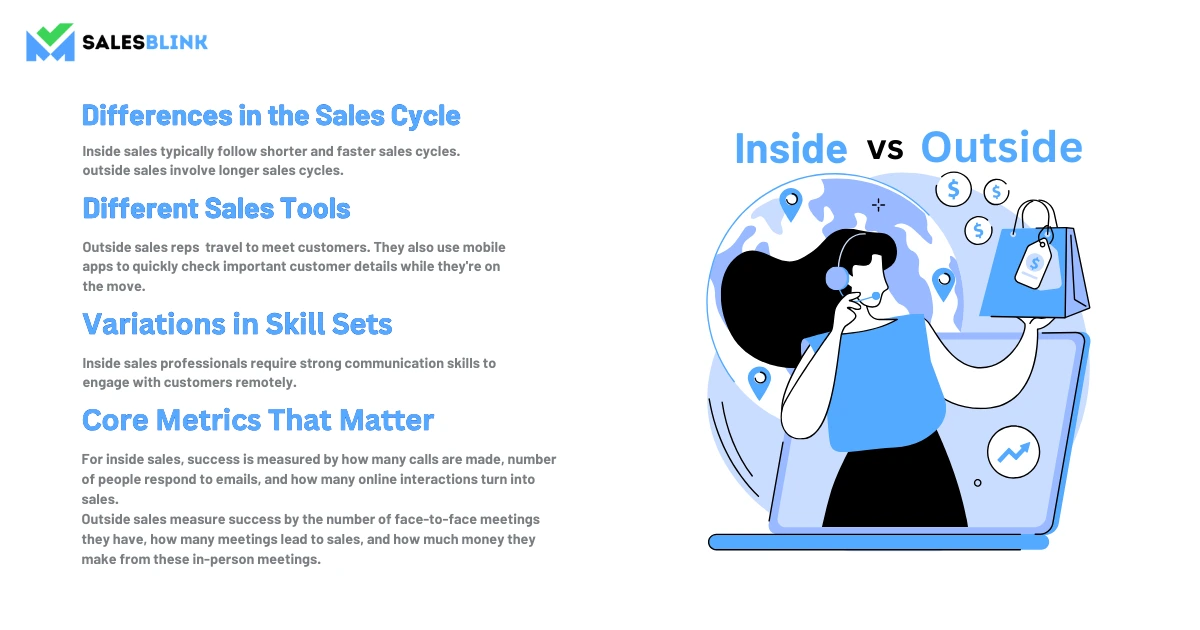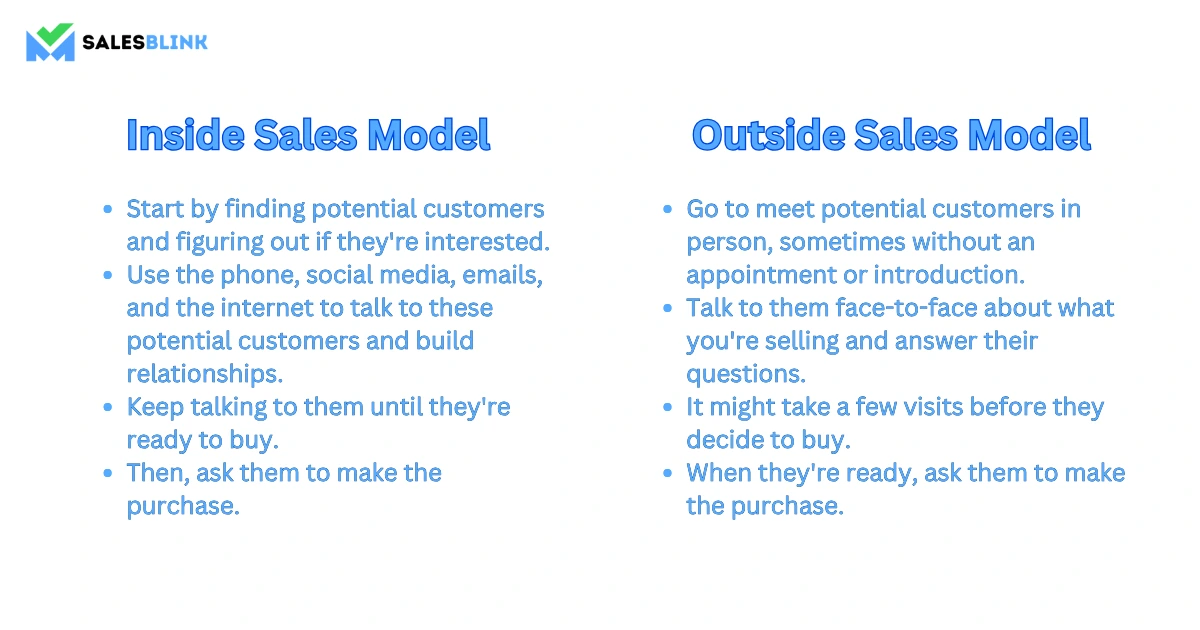Inside Sales vs Outside Sales: Understanding The Difference
Did you know that 80% of sales are made by 20% of salespeople? It’s a surprising fact highlighting the importance of understanding inside vs outside sales.
If you’re a new entrant in sales, you may be unfamiliar with these terms, and you might miss out on valuable opportunities or face challenges you’re unprepared for.
Imagine this scenario: You’re trying to sell a product or service but must figure out whether to meet potential clients face-to-face or communicate remotely. You might waste time and resources on the wrong approach and lose potential customers.
But fear not! This blog post will explore the sales world by exploring inside sales vs. outside sales. We’ll help you grasp the advantages and disadvantages of each approach, enabling you to make informed decisions and improve your sales strategy.
Let’s begin!
Table of Contents
- What is Inside Sales?
- What is Outside Sales?
- Inside Sales vs Outside Sales
- What Do Inside Sales Reps Do?
- What Do Outside Sales Reps Do?
- Pros & Cons of Inside Sales
- Pros & Cons of Outside Sales
- Inside Sales vs Outside Sales Salary
- Inside vs. Outside Sales Models
- Inside & Outside Sales Statistics
- Types of Sales Team Structures You Can Choose From
- How to Know The Right Sales Approach For Your Business?
What is Inside Sales?

Inside sales sells products or services where sales reps connect with potential customers through remote communication channels rather than meeting them in person. In this approach, sales teams use phone calls, emails, video conferencing, and other online tools to reach prospects, present their products or services, and close deals.
Inside sales have gained popularity due to technological advancements and changing customer preferences. This approach offers several advantages, such as cost-effectiveness, scalability, and the ability to reach a broader audience. Sales reps in inside sales have the advantage of working from a centralized location, allowing for efficient collaboration and sharing of resources.
The inside sales process typically involves:
- Identifying potential leads.
- Nurturing them through various communication channels.
- Guiding them through the sales funnel until a purchase decision is made.
This process often includes delivering product or service information, addressing customer questions and concerns, and negotiating terms.
Inside sales can be particularly effective for businesses that offer digital or easily accessible products and services. It permits sales reps to reach a global customer base without traveling. It also enables sales teams to track and analyze customer interactions more comprehensively.
What is Outside Sales?

Outside sales, also known as field sales, is a sales model where sales professionals meet potential customers in person to foster and sell products or services. In this approach, salespeople venture into the field, visiting clients at their locations, attending meetings, and engaging in face-to-face interactions. This personal touch is a key aspect of outside sales, making it different from inside sales, which relies on remote communication methods.
The outside sales strategy involves building relationships with clients over time. Sales professionals often work closely with clients to understand their needs, provide tailored solutions, and guide them through the entire sales cycle. This personal connection allows for a deeper understanding of customer preferences and challenges, making offering products or services that meet their requirements easier.
Further, outside sales work well for businesses selling expensive, detailed, or tailored products or services. In this approach, sales professionals meet customers face-to-face and can show how things work, give them a taste of the product, and quickly answer any questions. This hands-on approach is super helpful for convincing customers to make a purchase. It’s like when you go to a store, and the salesperson lets you try out a new gadget before you buy it.
Outside sales may require more time and effort than inside sales, but it often leads to greater profits because it allows salespeople to form close relationships and gain the trust of their clients. It’s a crucial part of a successful sales strategy that works alongside other methods to reach different customers and fulfill their specific needs.
Inside Sales vs Outside Sales
Let’s explore Inside Sales vs Outside Sales:

Differences in the Sales Cycle
One significant difference between inside and outside sales lies in their sales cycles. Inside sales typically follow shorter and faster sales cycles. Inside sales representatives use remote communication methods like phone calls and emails to reach potential customers swiftly. They can often move leads through the sales funnel more rapidly due to the ease of scheduling meetings and follow-ups.
On the other hand, outside sales involve longer sales cycles. Sales professionals invest more time nurturing relationships and providing personalized, face-to-face interactions. The physical nature of outside sales can extend the time it takes to close deals as it may require multiple meetings and visits to finalize agreements.
Different Sales Tools
Inside sales professionals use software tools to connect with customers. These tools include customer relationship management software, cold emailing platforms, and video conferencing apps. These tools help inside sales teams manage leads, track interactions, and maintain efficient communication with prospects.
Outside sales reps use some unique tools and methods. They travel to meet customers. They bring along things like brochures and product samples to show to the customers. Reps also use mobile apps to quickly check important customer details while they’re on the move. Sometimes, they use special tools to help them plan the best routes and schedules for in-person meetings so they don’t waste time driving around. These tools and tricks help outside salespeople make the most of their face-to-face customer meetings.
Variations in Skill Sets
Inside and outside sales require distinct skill sets. Sales skills used by inside sales professionals are strong communication skills, relying heavily on verbal and written communication to engage with customers remotely. They must excel at conducting virtual presentations and handling objections through digital channels.
Outside sales reps need different skills, including effective interpersonal abilities, to meet customers face-to-face. Building rapport, active listening, and adapting to non-verbal cues become crucial in these interactions. They must also be experts at product demonstrations and closing deals in person.
Core Metrics That Matter
For inside sales, success is often measured by how many calls are made, how many people respond to emails, and how many online interactions turn into sales. Reps doing inside sales usually get paid based on how well they meet their goals and make lots of sales happen.
On the other hand, outside sales measure success by counting how many face-to-face meetings they have, how many meetings lead to sales, and how much money they make from these in-person meetings. Outside sales reps often earn a portion of their pay as a bonus tied to the money they bring in from these personal meetings because making deals in person is a big deal.
Inside sales vs. outside sales represent two distinct approaches to selling products or services. While inside sales focus on remote communication, shorter sales cycles, and digital tools, outside sales prioritize face-to-face interactions, longer sales cycles, and specialized skills for in-person engagement.
Understanding these key differences is crucial for businesses to choose the right sales model and for sales professionals to hone their expertise in their chosen field.
What Do Inside Sales Reps Do?
The inside sales team typically handles tasks such as creating and nurturing leads until they’re ready for a sale or passing them on to an outside sales rep or account manager. Their duties may include:
- Connecting potential or existing customers to educate them about a product or service.
- Assessing potential clients, pinpointing their requirements, and matching them with suitable products or services.
- Addressing queries about the product or service.
- Inquiring to understand the customer’s needs.
- Documenting and updating customer details in sales software.
- Handling incoming calls from potential clients or existing customers.
- Initiating outgoing phone calls and tracking up on fresh leads.
- Convincing customers by addressing their concerns and objections is a crucial part of inside sales, ultimately helping inside sales teams close deals successfully.
What Do Outside Sales Reps Do?
Outside salespeople have an important job. They meet customers in person and make new sales while keeping the old customers happy. Here’s what they do:
- Build and keep relationships with customers.
- Listen to what customers need and offer solutions.
- Find new customers by looking for leads and following up on them.
- Manage a certain area or group of customers.
- Meet monthly, quarterly, and yearly sales goals.
- Talk to potential customers at events to make deals.
- Know their product or service well and match it to what customers want.
- Show and explain their product or service to possible customers in person.
Pros & Cons of Inside Sales
Pros of Inside Sales
- Cost-Efficient: Inside sales typically involve lower expenses as there’s no need for travel or physical presence, making it more budget-friendly.
- Wider Reach: Inside sales can connect with a broader audience, tapping into potential clients globally through digital channels.
- Efficient Sales Cycle: Inside sales often have shorter sales cycles as they can easily schedule meetings and follow-ups, speeding up decision-making.
Cons of Inside Sales
- Limited Personal Connection: Building relationships can be challenging when you don’t meet face-to-face, potentially impacting trust and rapport.
- Product Complexity: Selling complex or highly customized products may be more challenging without in-person demonstrations or samples.
- Overlooked Opportunities: Some potential clients prefer in-person interactions, and relying solely on inside sales may miss such opportunities.
Pros & Cons of Outside Sales
Pros of Outside Sales
- Building Personal Bonds: Outside salespeople create strong personal connections with customers, leading to more trust and customer loyalty.
- Great for Complex Sale: Outside sales work well for selling complicated, expensive, or unique products/services. Face-to-face meetings help explain and show these items effectively.
- Quick Learning: Talking directly with customers means getting instant feedback. It helps salespeople adjust their sales pitch right away.
Cons of Outside Sales
- Expensive: Outside sales cost more because of travel, hotels, and materials needed for in-person meetings.
- Takes More Time: Building relationships and closing deals in person can take a while, making the sales process longer.
- Limited to Certain Areas: Outside sales can only easily reach a few people, especially in different parts of the world. It takes more work to connect with a broad audience.
Inside Sales vs Outside Sales Salary
In this guide to Inside sales vs. outside sales, let’s explore the average annual salaries for different inside and outside positions in the US:
- Sales Associates:
- Average Base Salary: $49,823 per year
- Inside Sales Representatives:
- Average Base Salary: $69,987 per year
- Account Managers:
- Average Base Salary:$72,038 per year
- Business Development Roles:
- Average Base Salary: $75,073 per year
- IT Software Sales:
- Average Base Salary: $119,106 per year
Here’s the information presented for outside sales
- Field Sales Representatives:
- Average Salary: $90,340 annually
- Territory Sales Representatives:
- Average Salary: $99,303 annually
- Key Account Sales Managers:
- Average Salary: $124,550 annually
- National Sales Representatives:
- Average Salary: $104,418 annually
- Outside Sales Representatives:
- Average Salary: $108,663 annually
This breakdown offers a clear and concise overview of the average salaries, which can be valuable when considering the differences between inside sales vs. outside sales approaches.
Inside vs. Outside Sales Models
Let’s explore the inside sales vs. Outside sales models:

Inside Sales Model
- Start by finding potential customers and figuring out if they’re interested.
- Use the phone, social media, emails, and the internet to talk to these potential customers and build relationships.
- Keep talking to them until they’re ready to buy.
- Then, ask them to make the purchase.
Outside Sales Model
- Go to meet potential customers in person, sometimes without an appointment or introduction.
- Talk to them face-to-face about what you’re selling and answer their questions.
- It might take a few visits before they decide to buy.
- When they’re ready, ask them to make the purchase.
As you already know, inside sales is usually easier and costs less, but it can vary depending on the business. Outside sales involve more in-person meetings and can take longer to make a sale.
Inside & Outside Sales Statistics
Here are some important facts that can help us understand the inside sales vs. outside sales discussion:
- Outside sales teams spend more money, from 40% to 90%, to get new customers than inside sales teams.
- Typically, outside sales professionals earn around 14% more than those working inside.
- Making a phone call for inside sales costs about $50 on average, but it’s much higher, at $308 for outside sales.
- Salespeople spend little of their day talking to potential customers.
- Inside sales reps usually make about 33 cold calls every day.
- On average, outside sales reps successfully close deals with roughly 40% of their potential customers.
- Companies can see about 20% more sales if they take the time to build relationships with customers before trying to make a sale.
- Only about 21% of potential customers end up making a purchase. However, this number could be higher if more companies focused on building relationships with potential customers.
Types of Sales Team Structures You Can Choose From
Here are some common types of sales team structures:
1. Assembly line model
This type of team structure is a specific type of sales organization model where sales tasks are divided and specialized among team members, similar to an assembly line in a manufacturing process. In this structure, each team member has a specific role and responsibility in the sales process, and they work together sequentially to move leads through the sales funnel.
2. Pod structure
The pod structure is like the assembly line model but with even more specialization. It’s used in big companies. In this structure, different teams, called pods, have specific jobs in the sales process.
In this structure, some focus on finding potential customers, others on discussing the products, and some on closing deals and keeping customers happy.
These pods handle different areas, like certain places or types of industries, and they can also specialize in specific products.
So, in simple terms, the pod structure is like having several specialized teams within a big company, each doing a specific part of the sales job, which helps them do their tasks well.
3. Island Model
The island model is a bit different. Here, a sales manager leads a team of reps who do everything from finding potential customers to keeping them happy after they buy. Each rep does the whole sales job, from finding leads to making sales and caring for customers. This way, they know everything about their clients and what they need.
The island model is usually used by small companies or those in special markets where reps need to know a lot about their clients. It’s like having a small team of experts who can handle everything from start to end for their customers.
4. Combination Structure
Some companies have sales teams that are a mix of different structures. This way, they can be flexible and focus on different types of customers or areas. It also helps salespeople become more skilled because they get to do different jobs. This mix of structures also makes it easier for managers to keep track and ensure everyone is doing their job properly. So, it’s like having the best of different worlds in one sales team.
How to Know The Right Sales Approach For Your Business?
Choosing the best sales approach for your business is crucial for success. To decide, consider your products, target audience, and resources.
- Product Complexity: If your products are simple and don’t require hands-on demos, inside sales using remote methods may be cost-effective.
- Customer Preference: Think about how your target customers prefer to buy. If they like personal interactions, outside sales might be better.
- Budget: Consider your budget. Inside sales tend to be more budget-friendly due to lower travel costs.
- Sales Cycle: For shorter sales cycles, inside sales work well, but for complex deals that need nurturing, outside sales might be better.
- Geographic Reach: If your audience is widespread, inside sales can reach more people quickly, but for local markets, outside sales could be effective.
- Hybrid Sales: A mix of both might be the sweet spot, like having inside sellers and outside sales.
- Testing: Feel free to experiment. Try different approaches, gather data, and adjust based on what works best for your business.
Remember, the right approach might evolve as your business grows, so stay open to change and adapt to your customers’ needs.
Choose the Right Sales Approach
In this guide of inside sales vs. outside sales you saw that making the right choice between these sales approaches is vital for the success of any business. Understanding your product complexity, customer preferences, budget constraints, and geographic reach will guide you toward inside or outside sales—or even a hybrid model. Shorter sales cycles may favor outbound sales, while nurturing relationships may require an inside sales strategy.
Be open to testing different approaches, as what works best may evolve. Ultimately, the right sales approach aligns with your unique business needs, ensuring you effectively reach your target audience and drive success in the competitive sales world.
Do let us know if our guide helped you optimize your sales funnel!
FAQs
Inside sales reps work remotely, usually from an office, using phone, email, or video to connect with clients. Outside sales reps travel to meet clients face-to-face for discussions and deal closures.
Cost-effectiveness varies. Inside sales often have lower overhead due to no travel and can use technology for efficiency. Outside sales may have higher costs but can be effective for complex, high-value deals.
The choice depends on your business model, product complexity, and target market. If your product needs detailed explanations, outside sales may be better. Inside sales may be more efficient if it can be easily explained via phone or web. The budget also matters.







